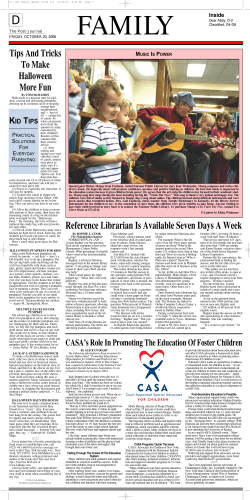
T ABA National Project to Improve Representation for Parents Investment that Makes Sense
ABA National Project to Improve Representation for Parents Investment that Makes Sense T he proof is in — providing parents with quality legal representation in child welfare cases isn’t just the right thing to do. It’s also the smart thing to do. High quality legal representation for parents involved in the child welfare system reduces the need for foster care placement and saves public dollars. Housed within the ABA Center on Children and the Law, the ABA National Project to Improve Representation for Parents is the only national legal organization with dedicated staff working to improve the practice of parents’ attorneys, educating child welfare decision-makers, and building a national community of parents and parents’ attorneys. The Project, guided by a steering committee of nationally recognized child welfare and legal experts, is the national leader of this important reform effort. Whenever we see investment in quality legal services for parents, professionals working in all parts of the system see an improvement in the functioning of child welfare: More families receive the services they need to raise their children safely Fewer children suffer the trauma of unnecessary removal from home Taxpayer dollars are saved “Parents’ lawyers—particularly when they work in offices staffed with social workers and parent advocates—are now being recognized as vital allies in helping the child welfare system achieve its preferred objectives: keeping children safely with their families... Parent representation would not be where it is today without the support of the ABA and its Parent Representation Project.” -Professor Marty Guggenheim, NYU Law School Better Outcomes for Children Even the most well-intentioned interventions have unintended consequences. Unnecessary placements or prolonged stays in foster care can be detrimental. Researchers at MIT found that compared to similarly situated children who remain at home, children placed in foster care face the following adverse outcomes: • Juvenile Justice. Approximately three times more likely to be involved in the juvenile justice system • Teen Pregnancy. More likely to become teen mothers • Employment. As a young adult, less likely to hold a job for at least three months • Incarceration. A two to three times higher arrest, conviction and imprisonment rate Children who remain home with their parents, often who are engaging in services, have improved life outcomes. A National Movement The ABA has been integral in advancing representation for parents. Before 2006, there were no nationally recognized standards of practice for parents’ attorneys and no source of technical assistance for practitioners. Today, through ABA work, there are: Widely accepted practice standards An active listserv connecting nearly 800 parent attorneys and parent advocates nationwide A biennial national conference focused exclusively on effective representation for parents’ attorneys The ABA is committed to this progress. Project staff continue to: Convene national and state parent representation leadership forums Help states assess current parent representation programs, create innovative pilot programs, and draft practice standards Organize regional parent attorney conferences Develop tools to evaluate and measure the impact of parent representation interventions. National Project to Improve Representation for Parents M uch more must be done to support innovative and effective parent representation programs around the country. Many parents still lack meaningful representation in cases involving the well-being of their families, which can result in unnecessary and prolonged separation for families, sometimes permanently. A continued national voice is needed to lead this effort. In too many communities without robust parental representation, the rate of children reunifying with family has been decreasing even though family reunification is the preferred and most common goal. Meaningful participation by parents and their attorneys is essential to a well-functioning child welfare court system. “…[A] barrier to parents receiving quality representation is funding. We need to elevate this work and help people understand how quality representation for parents helps achieve reunification. Better funding of parent representation will result in cost-savings.” - Minnesota Supreme Court Justice Helen Meyer, ret. When government entities and private funders invest in quality legal representation for parents, they see improved outcomes for the children and families the system is designed to serve. Programs across the country are showing that quality legal representation for parents is what’s best for children. What Works: A Multidisciplinary Approach Reports from three different and unique methods of delivering parent representation prove that quality parents’ attorneys, working as a team with social workers and parent mentors, can help reduce the need for foster care placement. New York: Center for Family Representation (CFR) Average 1.8 months in foster care for children of CFR clients, compared to a statewide average of more than 2 years Michigan: Detroit Center for Family Advocacy (CFA) Avoided the filing of a petition in the child welfare court system in all but four of the 55 pre-petition cases it handled. None of the 110 children involved entered foster care Washington State: Office of Public Defense (OPD) Parent Representation Program (PRP) A 36% increase in families’ reunification rates since the implementation of the PRP A Look Forward Today there are relatively few established multidisciplinary parent representation programs. Yet we have learned that by investing in this kind of high-quality parent representation, we can reduce the number of children removed from their parents and for those children removed, shorten the time they spend in foster care. With the ABA’s leadership, we can continue to work to ensure that parents and their attorneys always have a meaningful voice in the child welfare process. Support for this work is needed. To date, the Project has been supported exclusively through foundation partnerships. With increased support, the ABA National Project to Improve Representation for Parents can continue working to: Help every state train their parents’ attorneys and develop and implement standards of practice so that where a parent lives doesn’t dictate the quality of representation she receives Support the development of law school clinics focused on parent representation so that there is a new generation of well-trained attorneys dedicated to this work Educate local, state, and national leaders about the impact of high quality parent representation so that there are leaders in every state ready and equipped to make positive change For more information, contact Mimi Laver | [email protected] | 202-662-1736 www.americanbar.org/groups/child_law/what_we_do/projects/parentrepresentation ABA National Project to Improve Representation for Parents Legal Representation for Parents Facing the Loss of Their Children: The Right Thing to Do, The Smart Thing to Do Models that Work New York: Center for Family Representation (CFR) Every parent represented by CFR works with a team of lawyer, social worker, and parent advocate. Focus on helping clients access services, supporting them at case planning meetings, and working to facilitate frequent and meaningful family visitation. Representation begins at the first hearing of the case and continues until dismissal or reunification. Outcomes: Data starting in 2007 shows that more than 50% of the children of CFR clients avoid foster care placement all together. When foster care cannot be avoided, the average foster care stay for children of CFR clients is just 1.8 months compared to a statewide average of more than two years. Just 7% of children of CFR clients reenter care, compared to a statewide foster care re-entry rate of 15%. Cost Savings: CFR’s services cost approximately $6,500 per family over the case lifetime. That sum is vastly less than a single year of maintaining a child in an out of home placement, which in 2010 could range from $29,000 to as much as $200,000 per child per year. Michigan: Detroit Center for Family Advocacy (CFA) Focus on serving residents in the Osborn neighborhood of Detroit, a neighborhood with one of the highest rates of removal of children to foster care in the state. Represents parents during the child protection investigation. CFA clients are represented by a multidisciplinary team of a lawyer, social worker, and parent advocate. Use legal mechanisms – such as guardianships, child custody or personal protection orders, education and landlordtenant advocacy – to allow parents or their family members to care for their children without the need for foster care or child welfare court interventions. Outcomes: From 2009 through 2012, CFA handled 55 pre-petition cases involving 110 children. In all but four cases, CFA reached a resolution for the family and avoided the filing of a petition in the child welfare court system. Through its work representing parents, CFA prevented all 110 children from entering foster care. Cost-Savings: The average annual cost per family to deliver CFA services is $3,200. The average monthly foster care payment per child in Michigan, not counting court costs, is $2,248. Based on that average and the national average length of stay in foster care of 21.1 months, the cost for Michigan when a child enters foster care is $47,433. If we assume conservatively that 25% of the 110 children whose families received CFA representation would have entered foster care for the national average length of stay, the cost CFA saved Michigan for these cases would be $1,304,407. Washington State: Office of Public Defense Parent Representation Program (OPD) Handles approximately 7,000 ongoing parents’ representation cases and is wholly supported by state funds. Created on a pilot basis following investigative report showing indigent parents typically receive poor representation. Since 2000, the program has expanded from serving three counties to nearly all of the state’s counties. Key elements of the program include case load limits, attorney practice standards, access to expert services and program social workers, oversight of attorneys, and ongoing training and support. Outcomes: OPD has been favorably evaluated numerous times. A 2011 review of court records and orders in 1,817 child welfare court cases filed before and after implementation found that the percentage of children who reunified increased by 36%. Another study by Dr. Mark Courtney and Dr. Jen Hooks at the University of Washington found that the program was successful in helping children move out of foster care and into permanent homes significantly faster, concluding that it should be expanded throughout the state. Cost-Savings: The PRP saves the state much more than it costs. In 2013, due to the increased reunification and permanency impacts, the state avoided $20 million in state foster care and adoption subsidy costs and spent only $12.5 million for the program.
© Copyright 2025





















